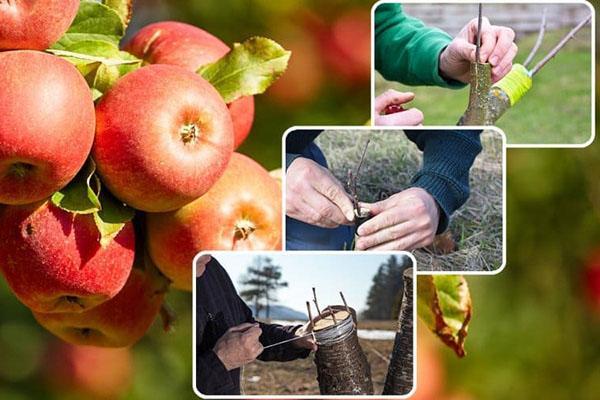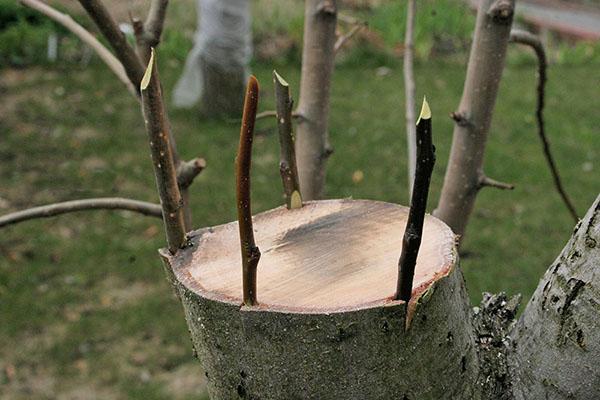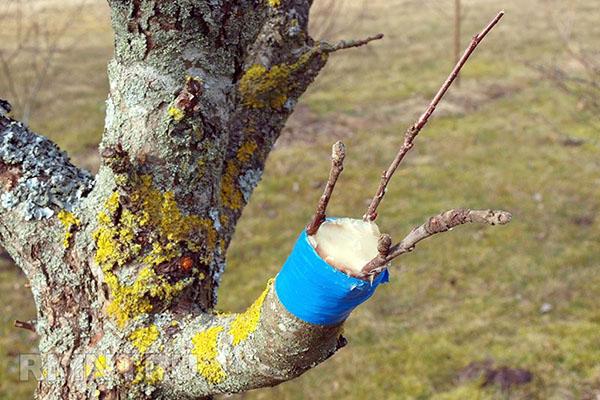When is it better to plant fruit trees: the jewelry work of gardeners
 Every farmer dreams of having a miracle tree in his garden, on which two different varieties of apple or pear trees will grow simultaneously. To get such an amazing exhibit, it is important to figure out when is the best time to plant fruit trees. As practice shows, this can be done in spring, summer or autumn. However, there are certain caveats to consider.
Every farmer dreams of having a miracle tree in his garden, on which two different varieties of apple or pear trees will grow simultaneously. To get such an amazing exhibit, it is important to figure out when is the best time to plant fruit trees. As practice shows, this can be done in spring, summer or autumn. However, there are certain caveats to consider.
When is the best time to plant fruit trees: from spring to autumn

When choosing a stock, it is necessary to pay attention to the fact that the fruiting time of the selected varieties coincides, as well as the shape of their crown. At the same time, they must be of the same type and with the same growth rate.
Spring Vaccination or "Good Morning Nature"
 In the spring, when all living things wake up, intensive sap flow in plants begins. Being in this state, the stock is an excellent breeding ground for scion. It is recommended to start the preparation of cuttings in the fall, when the culture is just entering a state of dormancy. However, the circumstances are not always the best. In this case, they are cut off before the buds begin to swell.
In the spring, when all living things wake up, intensive sap flow in plants begins. Being in this state, the stock is an excellent breeding ground for scion. It is recommended to start the preparation of cuttings in the fall, when the culture is just entering a state of dormancy. However, the circumstances are not always the best. In this case, they are cut off before the buds begin to swell.
In order for the alien tissues of different plants to grow together perfectly, it is recommended to pinch them from March to June. During this period, the "half-sleeping" scion will actively grow to the stock.
 The crop variety will also determine when to plant trees in April. For example, the beginning of this month is considered the most suitable time for pome varieties. To a greater extent, this applies to quince, pear or apple trees... The latest period for the procedure is June 15th.
The crop variety will also determine when to plant trees in April. For example, the beginning of this month is considered the most suitable time for pome varieties. To a greater extent, this applies to quince, pear or apple trees... The latest period for the procedure is June 15th.
The optimal timing of stone fruit vaccination is from March 20 to April 10. This is true for apricot, plum, or cherry.
In addition, it is worth noting that the air temperature during the event should not be lower than 10˚С, and at night it should not drop to 0˚С. Grafting trees in May is most often suitable for cherries. Nevertheless, the procedure should be carried out if spring has come late enough. Otherwise, in too hot weather, the scion simply will not take root.
Grafting trees in summer: when the heat is not a hindrance
 There are many reasons why tree grafting is practiced in summer (video below). The time and timing of grafting largely depends on weather conditions. The procedure should be planned for cloudy weather. However, it is important to ensure that there is no rain, otherwise the wood may swell. In summer, the appropriate hours for the event are morning or evening. In addition, after such an intervention, the stock must be shaded with a special cover made of branches.
There are many reasons why tree grafting is practiced in summer (video below). The time and timing of grafting largely depends on weather conditions. The procedure should be planned for cloudy weather. However, it is important to ensure that there is no rain, otherwise the wood may swell. In summer, the appropriate hours for the event are morning or evening. In addition, after such an intervention, the stock must be shaded with a special cover made of branches.
The cultivation of trees carried out in summer shortens the growing period by almost a whole year.
 To ensure 100% survival of the plant, it is necessary to cut off the scion along with a small supply of old bark. Still, it is worth remembering that only by the fall will the gardener be able to understand whether this event was successful.
To ensure 100% survival of the plant, it is necessary to cut off the scion along with a small supply of old bark. Still, it is worth remembering that only by the fall will the gardener be able to understand whether this event was successful.
Autumn tree grafting: what is the risk
 At this time of year, the natural world is amicably preparing to go to winter rest. In addition, there is a frequent change in weather conditions. In this regard, the optimal time for grafting trees in the fall falls on September or early October. To plan this jewelry business, the gardener needs to carefully monitor the air temperature, it should not fall below 15˚С.
At this time of year, the natural world is amicably preparing to go to winter rest. In addition, there is a frequent change in weather conditions. In this regard, the optimal time for grafting trees in the fall falls on September or early October. To plan this jewelry business, the gardener needs to carefully monitor the air temperature, it should not fall below 15˚С.
After October 15-20, all plants begin to prepare for wintering, so sap flow in them gradually stops. Namely, it depends on this process whether two parts of different plants will grow together.
Among other things, it is also necessary to learn some secrets of when to make clothespins on trees.
In most cases, a lot depends on the technique of the procedure:
- for budding - until September 15;
- by splitting or by copulation - until the beginning of October;
- the first days of autumn - in the bark.
Only young trees are taken as a rootstock for autumn grafting. On adult specimens, the survival rate of the scion drops low.
 Of course, these terms do not need to be considered unshakable, they are, in a way, approximate guidelines. Indeed, the southern regions have a completely different climate than the northern ones, and the sunny weather can last much longer.
Of course, these terms do not need to be considered unshakable, they are, in a way, approximate guidelines. Indeed, the southern regions have a completely different climate than the northern ones, and the sunny weather can last much longer.
Grafting fruit trees: all the secrets of the procedure
 In the original, this surgery is performed on wild trees. They also practice using old or broken cultivated plants as a stock. These specimens are permanent sources of nutrition, as well as the growth of young scions.
In the original, this surgery is performed on wild trees. They also practice using old or broken cultivated plants as a stock. These specimens are permanent sources of nutrition, as well as the growth of young scions.
They are vaccinated with the help of special devices:
- kidneys;
- branches;
- cuttings.
Each of these parts is cut off from collection varieties, so they carry all the varietal characteristics of the mother plant. This is just one of the reasons why fruit trees are grafted. Also, using this procedure, you can get a cultivated plant with all its varietal qualities without spending extra money and time. In addition, you can increase frost resistance apricots or to plant several different varieties at once. Some gardeners use this procedure to save damaged specimens. Nevertheless, one should always take into account the listed features of when it is best to plant fruit trees.
Seed propagation of cultivated plants does not allow preserving all their varietal advantages. For this reason, the scion method is popular among gardeners.
Mastery of garden surgery: copulation and budding
 Regardless of what timing of grafting fruit trees the agrarian chooses, he needs to properly carry out the event itself.
Regardless of what timing of grafting fruit trees the agrarian chooses, he needs to properly carry out the event itself.
In horticulture, there are 3 methods of grafting crops:
- Simple copulation. The scion and rootstock are cut at an acute angle. The thickness of each of these branches must be the same.
- Improved copulation. The long cut of each cutting is visually divided into 3 parts. Then a longitudinal incision is made from the edge up to 10-12 mm deep. The resulting parts are connected according to the principle of puzzles.

- Budding. One bud / eye in the form of a boat (length - 2-3 cm) is cut from the mother tree. A bark incision is made in the shape of the letter "T" on the stock. The scion is put into the resulting "pocket" and closed.

After such a surgical operation, you need to connect the scion and rootstock as tightly as possible. To prevent them from disintegrating, the vaccination site must be tightly bandaged. In this case, you can use electrical tape or a strip from a plastic bag. At each turn made, it is recommended to twist it.
All open sections of the plant should be lubricated with garden varnish. This will help protect the crop from many diseases.
There is also an easier way grafting trees into splitting... To do this, you need to cut the stump at a right angle and make a cross-cut in the middle.It is necessary to insert a wedge into it in order to freely insert the stripped branches, which have 5 buds each, into the hole. Then the retainer is pulled out, and the trunk is tied. The cut is treated with garden pitch.
To learn more about when is the best time to plant fruit trees, a gardener's usual observation will help. To do this, you need to carefully monitor how the scion feels, because each type of culture has its own characteristics. Moreover, the climatic conditions in each area are also different.